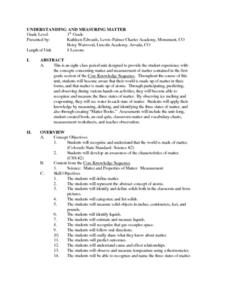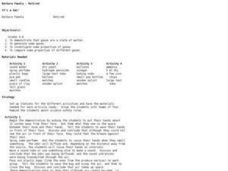Curated OER
What's Matter?
Students explore many of the basic properties of matter including atoms, ions, elements, molecules, and density. The class explores an interactive flash-animated Web site to answer questions and clarify misconceptions they might have had...
Curated OER
What is Matter?
Learners create a definition of matter. In this physical science lesson, students work in pairs to sort items printed on cards into several categories (matter, non-matter, and unsure) and agree on a definition of matter.
Curated OER
Comparing Matter
Students use Internet to research and discover states of matter and explain how molecules are arranged in each state, complete Comparing Matter Work Sheet, and identify objects around classroom that fit three states of matter definitions.
Curated OER
Phases of Matter
Students are introduced to the basic states of matter: solids, liquids and gases. Through experimentation, students determine that liquids and solids have definite volume, that gases do not have definite volume, and that solids have a...
Curated OER
Matters of Milk and Marshmallows
Young scholars observe a teacher demonstration o classifying matter by its physical properties of shape and size. After discussing the definition of matter, students describe the state of matter. They sing a song to the tune of "Bingo."...
Curated OER
Experimenting with Physical Changes
Fourth graders explore physical changes. They discuss that physical change is a change in size, shape, or state of matter of a substance. Students explore what change takes place when two substances can dissolve each other. They observe...
Curated OER
Solids, Liquids, and Gases
Learners explore solids, liquids, and gasses and categorize and describe the three states of matter. In this chemistry lesson, students categorize items as solid, liquid, or gas based on the definitions given by the teacher. Learners...
Curated OER
Understanding And Measuring Matter
First graders observe ice melting and water evaporating. They experiment with sugar and water and read the poem "Matter Really Matters." They define vocabulary words and sing a matter song.
Curated OER
Water 1: Water and Ice
Students investigate water in its solid and liquid form. In this states of matter lesson, students experiment to see what happens as water goes from a solid, ice, to a liquid, water, and back again. They write about and illustrate the...
Curated OER
Outrageous Ooze
Students examine states of matter. In this solids and liquids lesson, students conduct a scientific investigation that requires them to make ooze and record their observations pertaining to it.
Curated OER
The Three States of Matter: Energy Matters
Students examine the states of matter; solids, liquids and gases. They explain how the states of matter change from one to another.
Curated OER
States of Matter
Young scholars categorize items into one of the three states of matter. They participate in a demonstration in which they represent particles of matter. Finally, they complete an experiment in which they "race" top see who can make...
Curated OER
Science- Unit on Matter- Solids
Second graders identify and describe properties of matter.
They identify three forms of matter- solids, liquids, and gases with 100% accuracy. The student describes the properties of solid objects.
Curated OER
It's a Gas!
Students investigate gases and their properties by completing 4 activities. In this gases lesson plan, students perform activities to show that gases take up space, they diffuse, and that odors and vibrations pass through gases. They...
Curated OER
Matter
Third graders are introduced to the topic of matter. As a class, they brainstorm what they already know about matter and its properties. After completing a worksheet, they participate in an experiment in which they observe matter in...
Curated OER
Properties of Matter
Second graders investigate how objects can be described, classified and compared by their composition. They recognize that the same material can exist in different states. Students verify that things can be done to materials to change...
Curated OER
Properties of Matter
Third graders explore forms of matter through reading, hands-on science activities, and research using the Internet. Students create a booklet, directions given, that they title and decorate, to later serve as a review visualization...
Curated OER
Boot Reer Root Beer
Fifth graders investigate chemical reactions. In this physical science lesson, 5th graders make dry ice root beer and identify the type of change that occurs to the root beer mixture.
Curated OER
Oobleck!
Learners use Oobleck to investigate the properties of colloids. In this Oobleck and colloid lesson, students listen to the beginning of Bartholomew and the Oobleck by Dr. Seuss. They experiment with Oobleck (corn starch, water, and...
Curated OER
Matter
Pupils complete a unit of activities to learn about states of matter and how to measure matter. In this matter lesson, students complete 8 lessons to learn about matter, its states, and how to measure matter.
Curated OER
The Penny Factory
Fourth graders identify the characteristics of a simple physical and chemical change. They describe objects by the properties of the materials from which they are made and separate or sort items using these properties. Students explain...
Curated OER
Observing Popcorn
Fifth graders discover the process of boiling water and how it is part of the changing of states of matter. They observe a kernel of popcorn pop in a test tube with water and take notes of how the water changes to the form of a gas....
Curated OER
Faith-Based Initiatives: Separation of Church and State
Students examine the role of religion in everyday life. In this religion and ethics lesson, students investigate the use of government funds to support faith-based initiatives. The lesson calls for students to conduct research, watch...
Curated OER
The Heart of the Matter
Upper elementary pupils learn about the blood transportation system and anatomy of the human heart. They fill in an outline of the human heart (not included) focusing on the flow of blood to and from the heart. Using stethoscopes,...























